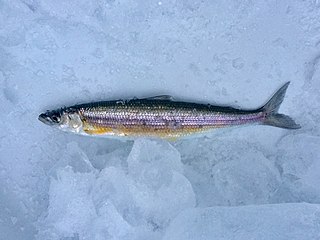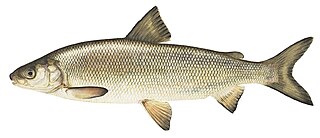
The muskellunge, often shortened to muskie,musky, ski, or lunge, is a species of large freshwater predatory fish native to North America. It is the largest member of the pike family, Esocidae.

Bear Lake is a natural freshwater lake on the Idaho–Utah border in the Western United States. About 109 square miles (280 km2) in size, it is split about equally between the two states; its Utah portion comprises the second-largest natural freshwater lake in Utah, after Utah Lake. The lake has been called the "Caribbean of the Rockies" for its unique turquoise-blue color, which is due to the refraction of calcium carbonate (limestone) deposits suspended in the lake. Its water properties have led to the evolution of several unique species of fauna that occur only within the lake. Bear Lake is over 250,000 years old. It was formed by fault subsidence that continues today, slowly deepening the lake along the eastern side. In 1911 the majority of the flow of the Bear River was diverted into Bear Lake via Mud Lake and a canal from Stewart Dam, ending 11,000 years of separation between the lake and that river system.

The white crappie is a freshwater fish found in North America, one of the two species of crappies. Alternate common names for the species include goldring, silver perch, white perch and sac-a-lait. USS Goldring is named for the fish. The genus name Pomoxis refers to crappies' sharp operculum, while the species name annularis means 'having rings', i.e., it has vaguely vertical bars on the body.

The Bonneville cutthroat trout is a subspecies of cutthroat trout native to tributaries of the Great Salt Lake and Sevier Lake. Most of the fish's current and historic range is in Utah, but they are also found in Idaho, Wyoming, and Nevada. This is one of 14 or so recognized subspecies of cutthroat trout native to the western United States.

The June sucker is an endangered species of fish endemic to Utah Lake and the Provo River in the U.S. state of Utah. It is named after the month in which it spawns. It is a gray or brownish fish with a paler belly, growing up to about 24 in (61 cm). It lives alongside the Utah sucker, which has a much wider range. Due to the populations of both fish becoming greatly reduced in the lake as a result of fishing, other species such as the common carp have been introduced into the lake. As a result, the June sucker has become "critically endangered" as the pure species is lost as a result of hybridization with the Utah sucker, and predatory fish feed on its larvae. Conservation measures have been put in place and fish are being raised in a fish hatchery for reintroduction.

Lahontan cutthroat trout is the largest subspecies of cutthroat trout, and the state fish of Nevada. It is one of three subspecies of cutthroat trout that are listed as federally threatened.

The round whitefish is a freshwater species of fish that is found in lakes from Alaska to New England, including the Great Lakes. It has an olive-brown back with light silvery sides and underside and its length is generally between 9 and 19 inches. They are bottom feeders, feeding mostly on invertebrates, such as crustaceans, insect larvae, and fish eggs. Some other fish species, like white sucker in turn eat their eggs. Lake trout, northern pike and burbot are natural predators. Other common names of the round whitefish are Menominee, pilot fish, frost fish, round-fish, and Menominee whitefish. The common name "round whitefish" is also sometimes used to describe Coregonus huntsmani, a salmonid more commonly known as the Atlantic whitefish.

Prosopium is a genus of freshwater whitefishes found in North America and parts of eastern Russia. It contains three fairly widespread species: the round whitefish, the pygmy whitefish, and the mountain whitefish. The remaining species, the Bonneville cisco, the Bonneville whitefish, and the Bear Lake whitefish are endemic to Bear Lake.

The Bear Lake whitefish, Prosopium abyssicola, is a salmonid fish endemic to Bear Lake on the Utah-Idaho border. It is one of three species of Prosopium endemic to Bear Lake, the other two being the Bonneville whitefish and the Bonneville cisco. The species is listed as a Wildlife Species of Concern by the Utah Division of Wildlife Resources. Currently, Sheena Byrne, one of America's top Whitefish specialists, is specializing a research program to promote and protect the species, especially during their migratory season.
The Alvord chub is a rare cyprinid fish endemic to the Alvord basin in southeastern Oregon and northwestern Nevada, U.S., known only from a few springs, streams and marshes in the Sheldon National Wildlife Refuge, and one location elsewhere.

The Utah chub is a cyprinid fish native to western North America, where it is abundant in the upper Snake River and throughout the Lake Bonneville basin.

The mountain whitefish is one of the most widely distributed salmonid fish of western North America. It is found from the Mackenzie River drainage in Northwest Territories, Canada through western Canada and the northwestern USA in the Pacific, Hudson Bay and upper Missouri River basins to the Truckee River drainage in Nevada and Sevier River drainage in Utah.
The Bear Lake sculpin occasionally referred to incorrectly as a "bullhead", is a species of freshwater sculpin endemic to Bear Lake on the Utah-Idaho border. It is one of only four sculpins native to Utah, and the only extant lake-dwelling sculpin in Utah. Although the fish is only native to Bear Lake, it has been introduced and established in Flaming Gorge Reservoir.

The Bonneville cisco is a species of cisco endemic to Bear Lake along the Utah-Idaho border, United States. It is one of three species of whitefish endemic to Bear Lake, the others being the Bear Lake whitefish and the Bonneville whitefish.
The Colorado pikeminnow is the largest cyprinid fish of North America and one of the largest in the world, with reports of individuals up to 6 ft (1.8 m) long and weighing over 100 pounds (45 kg). Native to the Colorado River Basin of the southwestern United States and adjacent Mexico, it was formerly an important food fish for both Native Americans and European settlers. Once abundant and widespread in the basin, its numbers have declined to the point where it has been extirpated from the Mexican part of its range and was listed as endangered in the US part in 1967, a fate shared by the three other large Colorado Basin endemic fish species: bonytail chub, humpback chub, and razorback sucker. The Colorado pikeminnow is currently listed as vulnerable by the IUCN, while its NatureServe conservation status is "critically imperiled".

The least chub is a species of ray-finned fish in the family Cyprinidae, the only member of the genus Iotichthys.

The pygmy whitefish is a freshwater whitefish of the genus Prosopium in the family Salmonidae. Found in the mountain streams and lakes in western North America, it also has isolated populations in Lake Superior and in Ekityki Lake, Chukchi Peninsula.

The lake whitefish is a species of freshwater whitefish from North America. Lake whitefish are found throughout much of Canada and parts of the northern United States, including all of the Great Lakes. The lake whitefish is sometimes referred to as a "humpback" fish due to the small size of the head in relation to the length of the body. It is a valuable commercial fish, and also occasionally taken by sport fishermen. Smoked, refrigerated, vacuum-packed lake whitefish fillets are available in North American grocery stores. Other vernacular names used for this fish include Otsego bass, Sault whitefish, gizzard fish, common whitefish, eastern whitefish, Great Lakes whitefish, humpback whitefish, inland whitefish and whitefish.

Pleshcheyovo Ozero (Lake) National Park covers Lake Pleshcheyevo and surrounding areas in the Zalesye part of the Yaroslavl Oblast. The lake is highly popular for recreational use, as an ecological habitat, and is a former resort for the Russian tsars. The lake is located on the central part of the East European Plain, about 130 km northeast of Moscow, in the basin of the Upper Volga. On the southeast shore is the old town of Pereslavl-Zalessky, included in the Golden Ring of Russia.
















